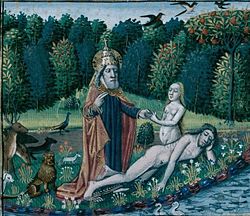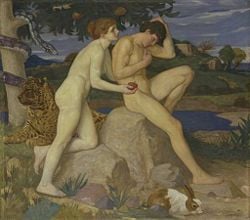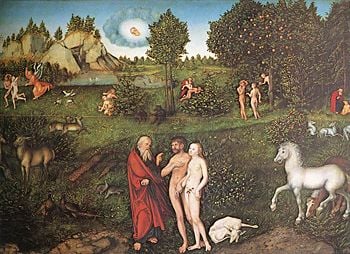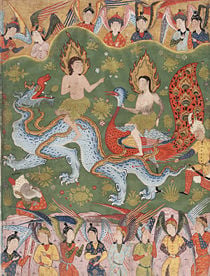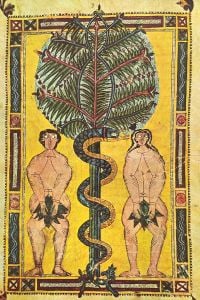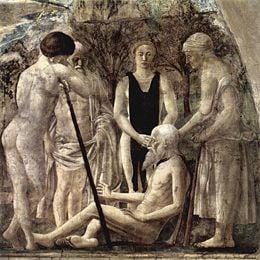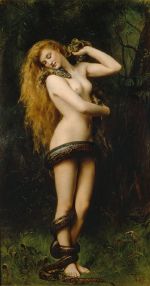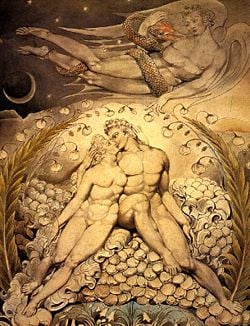Adam and Eve
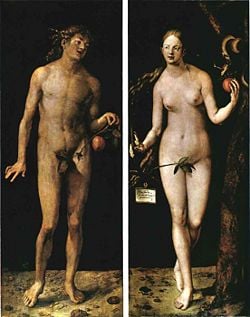
Adam (Hebrew: ×Ö¸×Ö¸×, Adam, "man") and Eve (Hebrew: ×Öˇ×Ö¸Öź×, Ḥavva, "living one") were the first man and woman created by God, according to the Bible and the Qur'an. The story of Adam and Eve is central to the widely held belief that God created human beings to live in a Paradise on earth, although they fell away from that state and formed the present world full of suffering and injustice. It provides the basis for the belief that humanity is in essence a single family, with everyone descended from a single pair of original ancestors. It also provides much of the scriptural basis for the doctrine of Original Sin, an important belief in Christianity, although not shared by Judaism or Islam.
The story of Adam and Eve is told in the early chapters of the Book of Genesis, which describes the creation of man and woman, the temptation and the Fall, the expulsion from Eden, the story of the first murder, and the subsequent peopling of the world outside the Garden of Eden. It is the source of many of the most important symbols in Western culture, including the Garden of Eden, the Tree of Life and the Tree of the Knowledge of Good and Evil, the forbidden fruit, and the serpent as Satan.
Adam and Eve's story underwent extensive elaboration in later Abrahamic traditions, and has been extensively analyzed by modern biblical scholars.
Biblical account
The creation of man and woman
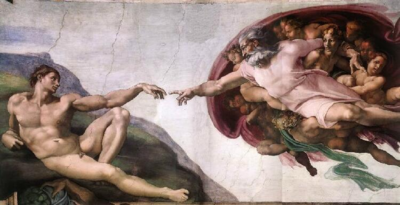
In the Book of Genesis, the creation of man and woman takes place after six "days" of creation in which God first brings into being the heavens and the earth, light, day and night, sky and sea, dry land, trees and other vegetation, the sun and the moon, sea creatures and birds, and finally livestock and wild animals. Then later on the sixth day, God decides to "make man in our image, in our likeness." The manifestation of God's image in "man" is both masculine and feminine:
- So God created man in his own image,
- in the image of God he created him;
- male and female he created them.âGen. 1:27
God proceeds to bless the couple to, "Be fruitful and increase in number; fill the earth and subdue it. Rule over the fish of the sea and the birds of the air and over every living creature that moves on the ground." (Gen. 1:28) God gives them, "every tree that has fruit with seed in it" to eat. At the conclusion of this sixth day of creation God declares His work to be "very good" and proceeds to rest on the seventh day.
In the Jewish and Islamic traditions, the creation of humanity out of a single pair signifies the moral unity and equality of humanity:
- But a single man [Adam] was created for the sake of peace among mankind, that none should say to his fellow, âMy father was greater than your fatherâ (Mishnah, Sanhedrin 4.5).
- O mankind! We created you from a single pair of a male and a female and made you into nations and tribes, that you might know each other [not that you might despise each other]. Verily the most honored among you in the sight of God is he who is the most righteous (Qurâan 49.13).
Genesis 2 contains a second account of the creation of human beings. However, unlike the first account which is chronological, the second one focuses on the theological significance of Adam and Eve. God forms Adam out of clay and breathes into him the "breath of life" (Gen. 2:7). Receiving this divine breath makes the man unique among all God's creations, which are made from the earth only. This verse provides a theological basis for making a qualitative distinction between human beings and animals, as only humans possess an eternal spirit. For some Protestants, the verse is also relevant to the abortion debate by providing a rationale for seeing the fullness of human life as beginning at birth when the baby takes its first breath, rather than, as Catholics believe, at conception when the "clay" has not yet been infused with spirit.
Institution of the family
God places Adam in the Garden of Eden. The Garden represents the world of God's love and care, where there is harmony among all creatures. It is described in the prophets as a place where "the wolf shall dwell with the lamb" (Isa. 11:6), and where there are riches and jewels in abundance (Ezek. 28:13). Yet what good is abundance if a man is dwelling alone? God seeks companions for Adam, and so creates the animals and brings them to Adam to give them names. As naming signifies dominion, this indicates human beings are a higher order of being than animals (compare Gen. 1:28). Yet Adam's relationship with the environment is also characterized as stewardship, as indicated by his purpose "to till the garden and to keep it" (Gen. 2:15). However, none of the animals are fit to be Adam's companion.
To create a fitting life companion, God forms a woman out of Adam's rib (Gen. 2:22). This means that woman is of the same substance as man. On this point, Thomas Aquinas wrote:
It was right for woman to be made from a rib of man. First, to signify the social union of man and woman, for the woman should neither use authority over man, and so she was not made from his head; nor was it right for her to be subject to manâs contempt as his slave, and so she was not made from his feet.[1]
A Jewish tradition, also found in some Gnostic texts, holds that God originally created Adam as a hermaphrodite (Midrash Rabbah, Genesis 7:1) so that Adam was both male and female. God later decided that "it is not good for 'it' to be alone," and brought the feminine Eve out of Adam, leaving Adam as masculine only.
With the creation of woman, Adam and Eve are complete, and after God brings the woman to the man, their oneness is confirmed: "This at last is the bone of my bones, and flesh of my flesh" (Gen. 2:23). This leads to the ordaining of the institution of marriage and family: "Therefore a man leaves his father and his mother and cleaves to his wife, and they become one flesh." (Genesis 2:24) Some Jewish traditions interpret this verse as suggesting that Adam and Eve enjoyed married life in the Garden, and the traditional Jewish wedding prayer refers to the joyous marriage of Adam and Eve. According to one midrashic account, when God blessed Adam and Eve in marriage, the angels danced and beat timbrels and stood guard over their bridal chamber (Pirḳe R. El. 12-13). However, most Christian interpreters do not believe that this marriage was consummated in the Garden of Eden; rather it was after the couple had been expelled that "Adam knew Eve his wife, and she conceivedâŚ" (Gen. 4:1).
The human fall
God had caused all kinds of trees to grow in the Garden of Eden, including two special trees: The Tree of Life and the Tree of the Knowledge of Good and Evil. Adam is told that he is free to eat of any tree he wishes, except one. God commands that he must not eat of the Tree of the Knowledge of Good and Evil, warning him that, "in the day you eat of it, you shall die" (Gen. 2:17). For a time, Adam and Eve obeyed the one commandment they have been given. However, one day, a serpent came to Eve and persuaded her to eat it. "God knows that when you eat of it your eyes will be opened," he told her, "and you will be like God, knowing good and evil." The serpent showed Eve that the fruit was, "good for food and pleasing to the eye, and also desirable for gaining wisdom," and so she ate it. She then gave some of the fruit to Adam, and he too ate. Adam and Eve immediately realized that they were naked, and became of ashamed of this, using fig leaves to cover their private parts.
In all the Abrahamic faiths, the serpent is linked with the figure of Satan, as in this New Testament verse: "That ancient serpent, who is called the Devil and Satan, the deceiver of the whole worldâŚ" (Revelation 12:9). As to what action is symbolized by eating the forbidden fruit, Christian theologians are generally vague. After all, it makes no sense that eating a literal physical fruit could damage what is spiritualâone's relationship with God and the integrity of his lineage. Rather, the focus is entirely on the disobedience that the deed entailed. Thus Calvin taught that Adam and Eve's disobedience stemmed from their pride and egoism, which turned their souls away from God.
Jewish tradition, on the other hand, is quite explicit that Satan (either in person or utilizing a serpent) seduced Eve. The Slavonic Book of Baruch, xcvii, says that the serpent had infused lust into the fruit, and when Eve ate it sexual desire was awakened in her. The Bahir, a Kabbalistic text, states: "The serpent followed Eve, saying, 'Her soul comes from the north, and I will therefore quickly seduce her.' And how did he seduce her? He had intercourse with her." (Bahir 199). In the Pirke d'Rab. Eliezer, Satan persuaded the serpent to act on his behalf and "Be my instrument, and through thy mouth will I utter a word which shall enable thee to seduce man" (Pirḳe R. El. xiii). In another tradition, Eve became the lover of Satan in the Garden of Eden, and Satan impregnated Eve to become the father of Cain (Pirḳe R. El. 13). The New Testament contains an echo of this idea in Jesus' statement, "You are from your father the Devil." (John 8:44) According to Unificationist teachings, the tragedy of the Fall was that by uniting in a sexual relationship with Satan, Adam, Eve and all humankind, who should have become God's family, were yoked instead to Satan's lineage and could therefore no longer recognize God as their Father. From the union with Satan they also inherited elements of his "fallen nature."
Soon after, God walked through the Garden looking for Adam and Eve, but he could not find them, because they were hiding from him. God called out to Adam: "Where are you" (Gen. 3:9). Adam responded, "I heard your voice, and I was afraid, because I was naked." God replied: "How did you know you were naked? Did you eat of the fruit of the tree I told you not to eat of?" By asking a question instead of judging and condemning him, God gave Adam the opportunity to own up to what he had done and repent. However Adam did not take responsibility for his action and instead put the blame on Eve. When God asked Eve a question, she too failed to take responsibility and instead she blamed the serpent. Since freedom and responsibility go hand in hand, when Adam and Eve denied they were responsible for their own actions, they denied they were free beings. In this way they put themselves under the dominion of Satan.
As a result of these events, God cursed all three of the characters in the drama: The serpent must crawl on his belly and eat dust; the woman must suffer increased pain in childbearing and be ruled by her husband; and the man must labor for his food instead of eating freely of what grows in the Garden, for the land too is cursed. (Gen. 3:14-19) These curses can be seen as analogues to the blessings given earlier in Gen. 1:28.
However, the curse upon the serpent contains what Christian exegetes have long regarded as a hidden prophecy of Christ to come in the words, "He (the woman's seed) will bruise your head, and you shall bruise his heel." (Gen. 3:15) This is said to foretell the crucifixion, by which Christ will strike the head of Satan while taking damage in his flesh.
God then confirmed the serpent's prophecy to Eve: "The man has now become like one of us, knowing good and evil" (Gen 3:21). To prevent Adam and Eve from also partaking of the Tree of Life and living forever, God cast them out of the Garden, posting cherubim and a flaming sword to guard the entrance. The death that Adam and Eve underwent when they ate the fruit was a spiritual deathâseparation from God and His blessings. Physically, they lived for many more years.
Life outside paradise
Adam and Eve then began their lives outside Eden and raised a family. Their first child was called Cain, and their second was named Abel. When they grew up, Cain became a farmer and Abel became a shepherd. Later, the two brothers each offered a sacrifice to God: Cain brought an offering of his crops, while Abel offered a sacrifice from his flocks. God accepted Abel's offering but rejected Cain's. As a result, Cain became dejected. God asked Cain why he was angry and told him that if he did well, he too would be accepted. On the other hand, if he does not, "sin is crouching at the door; its desire is for you, but you must master it." This phrase indicates that human beings are not determined. On the contrary, each person has the freedom to choose and is thus responsible for their actions. However, Cain did not change his outlook. Instead, he lured Abel into the field and killed him. Cain fled to the east, where his wifeânot previously mentionedâgave birth to Adam and Eve's first grandson, Enoch.
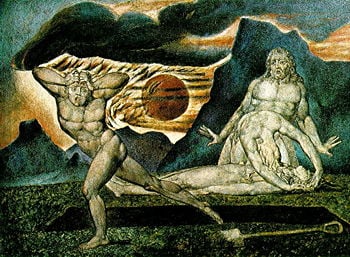
After this, Adam and Eve had another son, Seth, and Eve declared, "God has granted me another child in place of Abel, since Cain killed him." After Seth grew to maturity, he became the father Enosh. It was Seth's line that produced Noah, through whom humanity's lineage was perpetuated after the Great Flood.
A separate account of Adam's genealogy is given in Genesis 5. Here, neither Cain's nor Abel's lineage is mentioned. It is therefore assumed that Abel died without children. This account specifies that Adam was 130 years old when he became the father of Seth. It also claims that Adam lived 930 years before he died. Although Eve is not mentioned in this genealogy, she is given the title "the mother of all living" (Gen. 3:20).
The biblical account requires that there be daughters in order to provide wives for the sons. The Bible refers to other sons and daughters of Adam (Gen. 5:4), but they are not named. Post-biblical literature sought to remedy this lack. The Book of Jubilees, a pseudepigraphic text from the second century B.C.E., names two daughters: AzÝrâ and Awân, plus nine other sons, making 12 sons and two daughters in all. Jubilees goes on to state that Cain later married Awân, and Seth married AzÝrâ. According to other Jewish traditions, Cain had a twin sister named Lebuda, and Abel had a twin sister named Qelimath. In the Conflict of Adam and Eve with Satan, Cain's twin sister is named Luluwa, and Abel's twin sister is named Aklia.
Other pseudepigraphic texts give further details of Adam and Eve's life outside of Eden, notably the Life of Adam and Eve (also known as the Apocalypse of Moses).
Adam and Eve in the Qur'an
The Qur'an tells of آد٠(ĘžÄdam) in the surahs al-Baqara 2:30-39, al-A'raf 7:11-25, al-Isra 17:61-65, and Ta-Ha 20:115-124, where he is mentioned by name. In addition, the Qur'an repeatedly describes the creation of human beings from a single pair, sometimes with an allusion to the biblical narrative of the creation of Eve from Adam's rib:
- O mankind! Fear your Lord, who created you of a single soul, and from it created its mate, and from the pair of them scattered abroad many men and women. (Qurâan 4.1)
- O mankind! We created you from a single pair of a male and a female and made you into nations and tribes, that you might know each other [not that you might despise each other]. Verily the most honored among you in the sight of God is he who is the most righteous. (Qurâan 49.13)
As mentioned above, this is the basis for the Islamic belief in human equality and the essential unity of the human race.
Adam in the Garden of Eden is portrayed a glorious being, endowed with wisdom, and higher than the angels. When God orders the angels to bow to Adam, one of those present, the Jinni Iblis refuses, due to his pride, and assumes the role of Shaitan, the Tempter. This introduces the Qur'anic narrative of the temptation of Adam and his wife, their eating of the forbidden fruit, their subsequent expulsion from the Garden and their shame over their private parts, just as in the biblical account:
So by deceit [Satan] brought about their fall: when they tasted of the tree, their shame [private parts] became apparent to them, and they began to sew together the leaves of the Garden over their bodies. And their Lord called unto them: âDid I not forbid you that tree, and tell you that Satan was an avowed enemy unto you both?â They said: âOur Lord! We have wronged our own souls. If You do not forgive us and do not grant us Your mercy, we shall certainly be lost.â God said, âGet you down, with enmity between yourselves. On earth will be your dwelling place and your means of livelihoodâfor a time. Therein shall you live, and therein you shall die; but from it shall you be brought forth at last. (7:22-25)[2]
The Qur'an recognizes that there was a fall from grace, indicated by the expulsion from the Garden and the resultant state of "enmity." The dominant interpretation is that Garden was in heaven and Adam before his fall was a heavenly being, only to be expelled to the earth. Others dispute that, citing other verses that God's original purpose was to create humanity to live on earth, and there be God's vicegerent: "The Lord said to the angels: 'I will create a vicegerent on earth'" (2:29-30).
Eve is not mentioned by name in the Qur'an, but her Arabic name ŘŮاإ (HawwÄĘž) is frequent in Islamic tradition.
In the Qur'an, Adam and Eve eat of the forbidden fruit, but unlike the Bible story, they immediately repent of their sin:
- And their Lord called unto them: âDid I not forbid you that tree, and tell you that Satan was an avowed enemy unto you both?â They said: âOur Lord! We have wronged our own souls. If You do not forgive us and do not grant us Your mercy, we shall certainly be lostâ (7:22-23).
- Then his Lord chose him, and relented toward him, and guided him (20:122).
God forgives them but asks them to leave paradise and go to live on earth. Adam and Eve become separated from each other for many years. Eventually they prayed a sincere prayer of repentance and were reunited with God and each other on the Mount of Mercy on the Plain of Arafat. Adam was guided by the angel Gabriel to the site where the Ka'ba was to be. After walking round the site seven times, he built a shrine. Adam and Eve were then guided by Gabriel to perform Hajj. So Adam is seen as a prophet in Islam, the first example of true repentance. Islam has no concept of Original Sin, nor did the sin of the first couple create a "fallen nature" in their descendants.
The Qur'an also recounts the story of Adam's two sons Cain and Abelânamed Qabil and Habil in Islamic tradition.
Islamic commentators have embellished the Qur'an's account with additional details. Muhammad ibn Jarir al-Tabari wrote that after receiving the breath of God, Adam remained a dry body for 40 days, then gradually came to life from the head downwards, sneezing when he had finished coming to life. [3] The Shiite commentator al-Qummi records the opinion that Eden was not entirely earthly. Having been sent to earth after eating the forbidden fruit, Adam and Eve first arrived at mountain peaks outside MeccaâAdam on Safa, and Eve on Marwa. In this tradition, Adam remained weeping for 40 days, until he repented, at which point God rewarded him by sending down the Kaaba and teaching him to perform the Islamic duty of the Hajj.
Original Sin
The story of Adam and Eve forms the basis for the important Christian doctrine of Original Sin: "Sin came into the world through one man and death through sin, and so death spread to all men because all men sinned," said Paul of Tarsus in his Epistle to the Romans, writing in about 58 C.E. Later theological commentators directly connected Adam and Eve's disobedience to God's word as the foundation of mankind's sinful nature. St. Augustine of Hippo (354-430 C.E.) understood Paul to have taught that Adam's sin was hereditary. He held that Original Sin passed on from generation to generation through the father's sperm in the act of sexual intercourse:
- "Behold I was brought forth in iniquity, and in sin did my mother conceive me" (Psalm 51:5).
Christian belief connects the Original Sin to the atoning work of Christ, which cleanses it. The New Testament teaches that Jesus is the new Adam, who brings regenerating life to Christians. As Saint Paul wrote:
- The first man Adam became a living being; the last Adam, a life-giving spirit. The first man was of the dust of the earth, the second man from heaven (1 Cor. 15:45-47).
As the second Adam, Jesus succeeded where the first Adam failed. Thus, Jesus was obedient to the point of death on the cross, restoring Adam's disobedience of the commandment which held the penalty of death (Gen. 2:17)âor as Saint Paul put it, "For as in Adam all die, so also in Christ shall all be made alive" (1 Cor. 15:22). Jesus overcame Satan through his forty days on the Mount of Temptation thus restoring Adam, who succumbed to Satan's temptation in the Garden. Based on Christ's redemption, baptism is understood in Catholic and some Protestant traditions as the means eradicating the Original Sin. (In other branches of Christianity, baptism is a means of cleansing only the sins that were actually committed by the person being baptized.) Furthermore, the Catholic sacrament of marriage is said to restore the chastity lost at the fall.
Because Eve had tempted Adam to eat of the fatal fruit, several of the early Fathers of the Church held her, and all subsequent women, to be especially responsible for the Fall. "You are the devil's gateway," Tertullian told his female listeners in the early second century. [4] Although there is no mention of a new Eve in the New Testament, in Catholic tradition, Mary, the mother of Jesus, is seen as restoring Eve's sin by her giving birth to Jesus as a virgin. Justin Martyr, (165 C.E.) wrote, "Christ became a man by a virgin to overcome the disobedience caused by the serpent ⌠in the same way it had originated" (Dialogue with Trypho). Irenaeus of Lyon stated: "The knot of Eve's disobedience was loosened by Mary's obedience" (Adv. haereses, 3:22). And Ambrose of Milan (397 C.E.) said, "It was through a man and woman that flesh was cast from paradise; it was through a virgin that flesh was linked to God."
The beginnings of evil without the concept of Original Sin
As mentioned above, Islam has no concept of Original Sin, nor did the sin of the first couple create a "fallen nature" in their descendants. Rather, Adam is an exemplary figure as the first to repent and receive God's mercy. However, the Qur'an does recount the fall of Adam and Eve from a heavenly state in the Garden to a worldly state of struggle. Moreover, the story of Adam and Eve is bound up with the origin of Satan, the tempter who lies in wait to deceive and corrupt human beings. Thus does the story point to the origin of human rebellion against Godâby depicting the origin of Satan and his stratagems to deceive, waylay, and corrupt human beings, as well as man's susceptibility to Satan's schemes.
With some exceptions, Jewish tradition does not teach that Adam and Eve's sin was inherited by their descendants. Rather, the tendency to sin, called the yezer harah or "evil inclination," is part of mankind's original nature. Some traditions trace the origin of the evil inclination to the creation itself, to the "breaking of the vessels" in Kabbalistic teachings; others teach that God gave humans the evil inclination for their own good, to encourage procreation or to provide an opportunity for choice. In any case, where God gives a challenge, he also gives a solution: His commandments to humankind, which are to guide them to overcome this tendency and act righteously.
One such exception is the notion that the fall of Adam and Eve increased the propensity to sin, adding to the power of the evil inclination:
- If Adam had not sinned, he would not have begotten children from the side of the evil inclination, but he would have borne offspring from the side of the Holy Spirit. But now, since all the children of men are born from the side of the evil inclination, they have no permanence and are but short-lived (Zohar, Genesis 61a).
In the Latter-day Saints tradition, the fall of Adam and Eve is considered to be a blessing, a felix culpa or "happy fault." According to the Book of Mormon, if Adam and Eve had not transgressed, they would have lived forever in Eden in a state of innocence, never having sexual relations and never having children (2 Nephi 2:22-26). Without the fall, humanity would never have multiplied on the earth, enjoying the pleasures of family life. Furthermore, the fall was necessary that people might exercise moral agency, to know the joys of ethical living. Finally, the fall was necessary that humankind would know the grace of the redemption of Christ. For these reasons, Mormons consider the fall of Adam and Eve to have been within God's plan.
Historicity and modern critical views
Adam and Eve are considered in traditional Christianity and Orthodox Judaism as real historical people. Genesis 5:4 records Adam within a genealogy, and in the New Testament, the Gospel of Luke (chapter 3) traces Jesus' lineage back to Adam. Thus, in the biblical tradition, all human beings are descended from Adam and Eve.
In modern times the theory of evolution has challenged the Christian belief in the historicity of Adam and Eve. Biblical scholars who add the dates to the lineages described in the Bible put Adam and Eve at about 4,000 B.C.E. However, anthropologists have found human remains of much earlier homo sapiens, dating to around 130,000 B.C.E. for modern humans and much earlier than that for more primitive "human" species. Further, some interpret Genesis as speaking of other people living at the time of Adam and Eve. Cain is worried that people will kill him when he is sent away. He flees to the land of Nod, where he takes a wife and has children. While biblical literalists insist that this woman must have been his sister, others are led to conclude that in ancient times Adam and Eve were the special forebears of a special tribe or race who intermarried with other primitive humans. Many denominations no longer insist that Adam and Eve were the literal parents of humankind.
Some see a confirmation of the biblical account in the recent identification by geneticists of prehistoric individuals dubbed "Y-chromosomal Adam" and "Mitochondrial Eve." However, these two individuals are not thought by the scientific community to be the biblical Adam and Eve. Indeed, Mitochondrial Eveâthe common matrilineal ancestor of all humans alive todayâlived many millennia before Y-chromosomal Adam.
Thus, many moderns consider the story of Adam and Eve as a myth, whose importance is in the lessons it conveys rather than the historical reality it supposedly describes. As a myth it is rich with metaphor and symbolism which can be understood at many different levels and many different ways. It expresses in narrative form a type of theology that touches on the deepest human questions. As a narrative type of theodicy it tries to explain how it is possible to still believe in the goodness of God despite the human experience of evil and suffering because it is not God's fault that there is evil and suffering. It does this by telling a story in which the first two human beings are responsible, by freely choosing to disobey God and creating an abusive and dysfunctional family tradition that was passed on to succeeding generations. Indeed, theologians return to the story of Adam and Eve time and again, capturing new theological insights to further illuminate these questions.
Historical-critical biblical scholarship
Biblical critics employ historical-critical methods to understand the original provenance of a text: Who wrote it, when it was written, for what purpose, and how it was understood by its audience. The biblical story of Adam and Eve in Genesis 2-3 is widely regarded has having been written by the Yahwist, or J, who lived in the tenth century B.C.E. around the time of King Solomon. The story was most likely composed in opposition to Canaanite mother-goddess worship, which employed sacred prostitutes in fertility rituals to induce the heavens to provide rain and abundant crops.[5] The goddess Asherah was central to this cult, and her worship, always denounced by the biblical prophets, was associated with trees (or wooden poles) and cultic sex (Deut. 23:17-18; 1 Kgs. 14:23-24; Hos. 4:12-14; Jer. 2:20). Thus, many scholars favor a sexual interpretation of the story, not as a condemnation of sexuality per se (God sanctions the marriage bed in Gen. 2:18-24), but of sexual relations outside of marriage, specifically associated with the Canaanite fertility cult.
Scholars have identified the term "knowledge of good and evil" as meaning sexual experience, notably in the Qumran text, the Rule of the Community: "He shall not come near to a woman, in order to have sexual relations with her, until his completing twenty years, when he knows good and evil" (1.9-11).[6] Several times in Genesis, the verb "to know" implies carnal knowledge (Gen. 4:1, 19:5, 24:16). An important extrabiblical parallel is the Mesopotamian epic of Gilgamesh, in which the hero's companion Enkidu is a type of Adam: Innocent and living wild among nature, he is seduced by a prostitute, after which he can no longer return to the wild, as the animals run away. Instead he gains a type of wisdomâshe says to him, "Thou art wise, Enkidu, art become like a God" (1.4.35). Enkidu becomes ashamed of his body and enters the human world. Ultimately he dies, cursing the harlot who brought him out from his primordial state (7.3.10-30).
Furthermore, in the fertility cult, Asherah was sometimes symbolized by a serpent. On Syrian and Egyptian plaques and statuettes of the goddess, she is depicted nude, her hair in flowing curls, standing on a lion and holding in her hands flowers and/or serpents.[7] As Asherah is the mother-goddess, Eve is called "mother of all the living" (Gen. 3:20), and her name, Ḥawwâ is related to an Aramaic word for serpent (Ḽiwyat). Was Eve one of Asherah's names? One Punic inscription begins "O Lady Ḥawwat, Goddess." In a Ugaritic text that illuminates the connection between serpents and the fertility cult, RS 24.244, a goddess has shut herself in her house and demands of the god Horan that he give her serpents as a "bride price" ('tnn), which in the Hebrew Bible is etnÄn, the term for a harlot's hire. Only after he has offered her serpents does he enter her temple, and together they fulfill the sacred marriage to bring healing and fertility to the land. In this text, the serpent can bring either death (through snake-bite) or life and healing. The symbol of medicine to this day is the Caduceus, a pole with entwined serpents.
In the story of Adam and Eve, all these aspects of the fertility cult are brought together and turned upside-down, becoming the source of all human corruption. The scene in Genesis 3 contains all the elements of the sacred marriage: The sacred ground of Eden, the tree as the cult-place of Asherah and source of healing and fertility, the serpent as symbol and mediator of the cult, as well as of the male sexual organ, a woman called by one of Asherah's titles, and the man. Together they do something which is supposed to make the couple like God, thus seeking what all those engaged in the ritual sex of the fertility cult were promised: Participation in the numinous power of uniting the cosmic male and female principles, mingling the human and divine energies to bring healing and fertility to the world. But just as in Numbers 25:1-15, where the Canaanite fertility cult promised healing but brought death, in Genesis 3 the results of the ritual sex are curses: Infertility, barren land, pain in childbirth, and death.
The Yahwist is inspired to place this story at the beginning of human history, as the original evil that caused humanity to be driven out of paradise. Set in primordial time, it is the opposite of creation. The chain of ever increasing evils continues through the opening chapters of Genesis as the Yahwist narrates Cain's murder of Abel, the violent generation of the Flood, and the hubris of the Tower of Babel, until in Genesis 12:2-3 God's blessing can enter the world anew through Abraham.
Alternative traditions about Adam and Eve
Lilith
Even in ancient times the presence of two distinct accounts of the creation of humanity in Genesis chapters one and two was noted with some curiosity. The first account says "male and female He created them," whereas in the second account God created Adam first and later brought Eve forth from Adam's body, because Adam was lonely. To resolve this apparent discrepancy between the two chapters, some rabbis suggested that chapter one's "woman" and chapter two's "Eve" were two separate individuals.
Preserved in the ancient midrashic accounts and the medieval Alphabet of Ben Sira, this Jewish tradition held that Adam's first wife, called Lilith, refused to take the submissive position to Adam in sexual intercourse, and eventually fled from him, consequently leaving him lonely. In some accounts, she goes on to become a demon responsible for much mischief throughout history.
Some rabbis believed that half-human demons arose from Eve's having sex with male spirits (Hag. 16a). In another talmudic tradition, ghouls and demons are engendered by Adam's ejaculations during a 130-year period of separation from Eve. Elsewhere, Lilith is also identified as the mother of these satanic creatures. The demons were said to prey on newborn males before they had been circumcised, and so a tradition arose in which a protective amulet was placed around the neck of newborns.
Gnostic Adam and Eve
In certain forms of Christian Gnosticism, the creation of Adam as Protanthroposâthe original manâhad a very important place. As in some rabbinical traditions, the Apocalypse of Adam suggests that man and woman were originally conjoined in a single androgynous being, both male and female. This primordial "man" was greater than the eternal angels and higher even than Samael, the god of the Aeon and Powers that had created them. Samael then separated the male Adam from the female Eve, causing their superior knowledge of God to be lost. The Protanthropos is also sometimes seen as a spiritual emanation from God, called the Son of God, which appeared to mankind as Jesus.
In a similar vein, though without reference to the above cosmology, the Gospel of Thomas quotes Jesus as saying: "When you make the two into one, and when you make the inner like the outer and the outer like the inner, and the upper like the lower, and when you make male and female into a single one⌠then you will enter the kingdom."
Some Gnostics adopted the Marcionite belief that the wrathful Yahweh of the Old Testament and the loving Heavenly Father of Jesus were two separate divinities. Gnostic accountsâparticularly those of the Ophitesâalso sometimes portrayed the serpent as a hero who was trying to help the first couple gain knowledge to defeat the jealous Demiurge of the material world.
Notes
- â Summa Theologica 1.1.92.3
- â Abdullah Yusuf Ali (trans.), The Holy Qur'an (Wordsworth Editions Ltd, 2001, ISBN 978-1853267826).
- â On The Transmitters Of Isra'iliyyat Islamic Awareness, 2000. Retrieved August 16, 2018.
- â Tertullian, "De Cultu Feminarum," Book I Chapter I, Modesty in Apparel Becoming to Women in Memory of the Introduction of Sin Through a Woman (in "The Ante-Nicene Fathers"). Tertullian Project. Retrieved August 16, 2018.
- â J. Alberto Soggin, Old Testament and Oriental Studies (Biblica et Orientalia 29) (Rome: Biblical Institute, 1975).
- â Robert Gordis, Poets, Prophets and Sages (Bloomington, IN: Indiana University, 1971, ISBN 978-0253166555), 199-201.
- â James B. Pritchard (ed.), Ancient Near East in Pictures Relating to the Old Testament (Princeton University Press, 1974), plates 469-477.
ReferencesISBN links support NWE through referral fees
- Ali, Abdullah Yusuf (trans.). The Holy Qur'an. Wordsworth Editions Ltd, 2001. ISBN 978-1853267826
- Cassuto, Umberto. From Adam to Noah. Jerusalem: Magnes Press, 1978. ISBN 965223480X
- Gordis, Robert. Poets, Prophets and Sages. Bloomington, IN: Indiana University, 1971. ISBN 978-0253166555
- Kikawada, Isaac M. & Arthur Quinn. Before Abraham was â The Unity of Genesis 1-11. Ignatius Pr; Repr. ed., 1989. ISBN 9780898702392
- Lacocque, Andre. The Trial of Innocence: Adam, Eve, and the Yahwist. Wipf & Stock Publishers, 2006. ISBN 978-1597526203
- Morris, Henry M. The Genesis Record: A Scientific and Devotional Commentary on the Book of Beginnings. Baker Books, 1995. ISBN 9780801060045
- Pagels, Elaine.Adam, Eve, and the Serpent. Vintage, 1989. ISBN 978-0679722328
- Pritchard, James B. (ed.). Ancient Near East in Pictures Relating to the Old Testament. Princeton University Press, 1974. ISBN 978-0691035024
- Ratzinger, Joseph Cardinal (now Pope Benedict XVI). In the Beginning. Wm. B. Eerdmans Publishing Co, 1995. ISBN 978-0802841063
- Schearing, Linda S. Eve & Adam: Jewish, Christian, and Muslim Readings on Genesis and Gender. Indiana University Press, 1999. ISBN 978-0253212719
- Soggin, J. Alberto. Old Testament and Oriental Studies (Biblica et Orientalia 29). Rome: Biblical Institute, 1975. ASIN B0040064KG
- Zornberg, Avivah Gottlieb. Genesis, The Beginning of Desire. Jewish Publication Society of America; 1st ed., 1995. ISBN 9780827605213
Credits
New World Encyclopedia writers and editors rewrote and completed the Wikipedia article in accordance with New World Encyclopedia standards. This article abides by terms of the Creative Commons CC-by-sa 3.0 License (CC-by-sa), which may be used and disseminated with proper attribution. Credit is due under the terms of this license that can reference both the New World Encyclopedia contributors and the selfless volunteer contributors of the Wikimedia Foundation. To cite this article click here for a list of acceptable citing formats.The history of earlier contributions by wikipedians is accessible to researchers here:
The history of this article since it was imported to New World Encyclopedia:
Note: Some restrictions may apply to use of individual images which are separately licensed.
